X-Matrix Cards
A way to illustrate the relationships between short and long-term goals.
![]() REQUIRED: The X-Matrix Module must be enabled for your organization to perform the functions on this support page. Reach out to your Customer Success Manager to enable it.
REQUIRED: The X-Matrix Module must be enabled for your organization to perform the functions on this support page. Reach out to your Customer Success Manager to enable it.
Many organizations that implement a formal Hoshin Kanri or Strategy Deployment process utilize X-Matrices to develop and implement tactical and strategic plans coordinated across people throughout the organization. This type of approach promotes organizational learning, faster corrections, and breaks down silos.
X-Matrix Cards let you add X-Matrices to any Board. They can be used to illustrate the relationships between short- and long-term goals, referencing Items, Boards, and people.
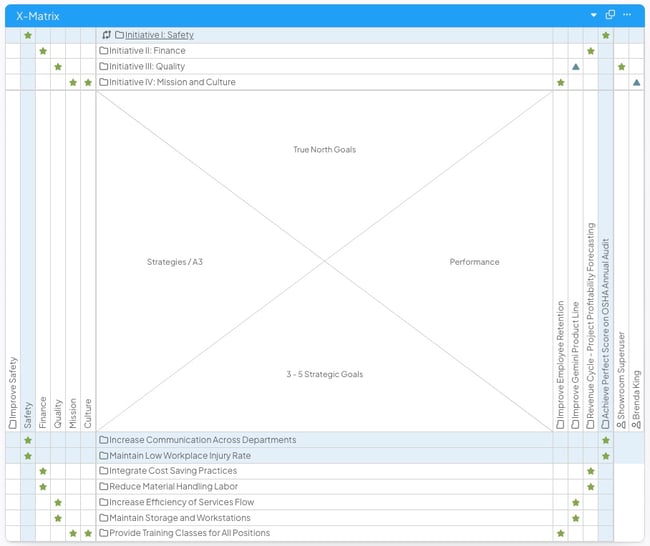
Example of an X-Matrix Card. Attributes mark correlated rows.
Keep reading to learn about the following:
Add an X-Matrix Card
Who can add an X-Matrix Card?
Anyone who has the "X-Matrix Administrator" permission and permission to add Cards to a Board can add an X-Matrix Card.
Only the following people can add Cards to a Board:
- The Board's Owner, if they have the "Create Boards" permission.
- The Board's Editors, if they have the "Create Boards" permission.
- Anyone with the "Board Administrator" permission for Boards in that Board's Location.
![]() Boards can have up to 16 Cards. Once a Board has 16 Cards, you won't be able to add or copy additional Cards to that Board.
Boards can have up to 16 Cards. Once a Board has 16 Cards, you won't be able to add or copy additional Cards to that Board.
Add a new X-Matrix Card
Open the Board with which you want to work, then:
- Click Add in the top right corner of the Board.

- Click X-Matrix in the resulting drop-down menu and the X-Matrix window will open.
- Name (required): The name will appear in the Card's primary header and can be used to identify this Card.
- Correlation Type (required): Expand the drop-down to select the Attribute that should be used to denote correlations between rows on the X-Matrix.
- The Respect Board Filter(s) checkbox: When this box is checked, the X-Matrix will only show information that meets the Board's filter requirements. When unchecked, the X-Matrix will show all information added to it at all times, regardless of the Board's filters.
- The South quadrant: This quadrant typically contains breakthrough objectives that are 3-5 years out.
- Quadrant Name (required): The name will be used to identify this quadrant.
- Quadrant Rows: Use the search field to search for and select the Items, Boards, or people that should be listed in this quadrant.
- To add a free-text row, click Add Text Row. Enter some text into the new row.
- To quickly add all Items that meet certain requirements, click Add Filtered Items. Add any necessary filter rules and click Save.
- The Items that meet those filter requirements will not be listed on the X-Matrix window but will appear on the Card itself once it's created.
- When you add a Location rule to the Item Filter, you will see a Use Board Location Filter checkbox. This checkbox only appears while filtering X-Matrix Cards. Selecting it will automatically apply the Board's selected Location to the filter.
- To quickly alphabetize all rows in this quadrant, click the Alphabetize button.
- To delete a row from the quadrant, hover over the row so that it's highlighted blue and click the x button.
-
- The West quadrant: This quadrant typically contains the annual objectives that align or nest under each of the longer-term breakthrough objectives.
- Configure this quadrant as described previously.
- The North quadrant: This quadrant typically contains the annual improvement opportunities and priorities, each aligning with an annual objective.
- Configure this quadrant as described previously.
- The East quadrant: This quadrant typically contains the specific metrics that will be used to measure each of the short-term initiatives.
- Configure this quadrant as described previously.
- Resources: This region typically contains the names of the people responsible for each project, metric, and goal.
- Location (required): Expand the drop-down to choose in which position the Resources region should be placed.
- Configure the rest of this region as described previously.
- The West quadrant: This quadrant typically contains the annual objectives that align or nest under each of the longer-term breakthrough objectives.
- Click the Headers section to expand it. For each of the following, you can enter a header that will be displayed on the X-Matrix.
- Northwest Correlation: Will be displayed over the West quadrant.
- North Header: Will be displayed over the North quadrant.
- Northeast Correlation: Will be displayed over the East quadrant.
- Southwest Correlation: Will be displayed under the West quadrant.
- South Header: Will be displayed under the South quadrant.
- Southeast Correlation: Will be displayed under the East quadrant.
- Resources: Will be displayed over the Resources values.
- Click the Text Options section to expand it.
- The Wrap Text checkbox: When enabled, the text in the North and South quadrants' rows will wrap if necessary. The East and West quadrants will truncate instead of wrapping.
When disabled, the text in all four quadrants will truncate if necessary.
- The Wrap Text checkbox: When enabled, the text in the North and South quadrants' rows will wrap if necessary. The East and West quadrants will truncate instead of wrapping.
- Click Add. The Card will be created and added to the top left position on the Board.
![]() PRO TIP: After your X-Matrix has been added to your Board, you may need to adjust the height of the Card to neatly display your data. Click the bottom border of the Card and drag it to the appropriate height.
PRO TIP: After your X-Matrix has been added to your Board, you may need to adjust the height of the Card to neatly display your data. Click the bottom border of the Card and drag it to the appropriate height.
Edit an X-Matrix Card
Who can edit an X-Matrix Card?
Anyone who has the "X-Matrix Administrator" permission and permission to edit the Card can edit an X-Matrix Card.
Only the following people can edit a Card:
- The Board's Owner, if they have the "Create Boards" permission.
- The Board's Editors, if they have the "Create Boards" permission.
- The Card's Editors
- Anyone with the "Board Administrator" permission for Boards in the Board's Location.
- Anyone who can access the Board and has the "Card Administrator" permission for Cards in the Card's Location.
Edit an X-Matrix Card
To edit an X-Matrix Card, locate the Card with which you want to work, then:
- Click the ellipsis in the top right corner of the Card.
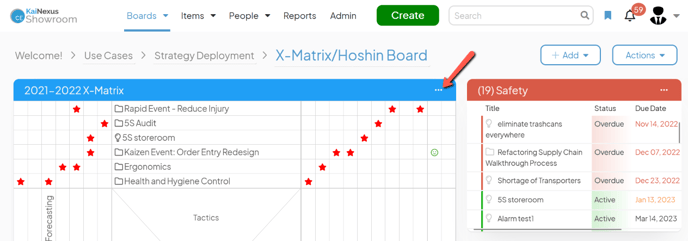
- Click Edit in the resulting drop-down menu.
- Update any elements of the X-Matrix as described above.
- Click Save.
Working with X-Matrix Cards
The Basics
- Click any Item or Board listed on an X-Matrix Card to open it. Click any person listed to open their profile.
- Items you don't have permission to see will be listed as "Private" and you won't be able to access them from an X-Matrix Card.
- If Correlation Attribute Values have been added to the X-Matrix, hover over any of their icons to display that Value's name.
- Hovering over a row in an X-Matrix will now highlight correlated rows in all four quadrants, helping you visualize associations across the entire X-Matrix.
Add Correlations to an X-Matrix
When the X-Matrix Card was created, a Correlation Attribute was chosen. Any one of that Attribute's Values can therefore be added at the intersection of two rows on the X-Matrix to provide a measure of how those rows are related to one another.
/Ofie/Ofie%20Profile%20Pic.png?width=50&height=50&name=Ofie%20Profile%20Pic.png) Who can add Correlations to an X-Matrix? Anyone who has the "X-Matrix Administrator" permission and permission to edit the Card can add Correlations to an X-Matrix Card.
Who can add Correlations to an X-Matrix? Anyone who has the "X-Matrix Administrator" permission and permission to edit the Card can add Correlations to an X-Matrix Card.
Only the following people can edit a Card:
- The Board's Owner, if they have the "Create Boards" permission.
- The Board's Editors, if they have the "Create Boards" permission.
- The Card's Editors
- Anyone with the "Board Administrator" permission for Boards in the Board's Location.
- Anyone who can access the Board and has the "Card Administrator" permission for Cards in the Card's Location.
To add Correlations to an X-Matrix Card, locate the Card with which you want to work, then:
- Click the intersection between the two rows to which you want to add a Correlation. A drop-down listing all available Values will appear.
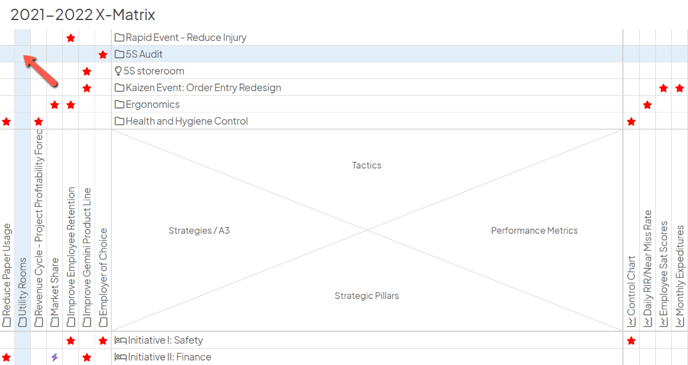
- Click the appropriate Value, and its icon will appear at the rows' intersection.
- To clear an existing Value from an intersection entirely, click None in the drop-down.
Filter the View of your X-Matrix
X-Matrices are complex structures with many rows and correlations. You might want to narrow down the view of an X-Matrix to only focus on one set of correlated rows.
Use the "View only correlated Items" filter to focus on key portions of your X-Matrix.
- Hover over any row in your X-Matrix. A "View only correlated Items" icon will appear to the left of the row.
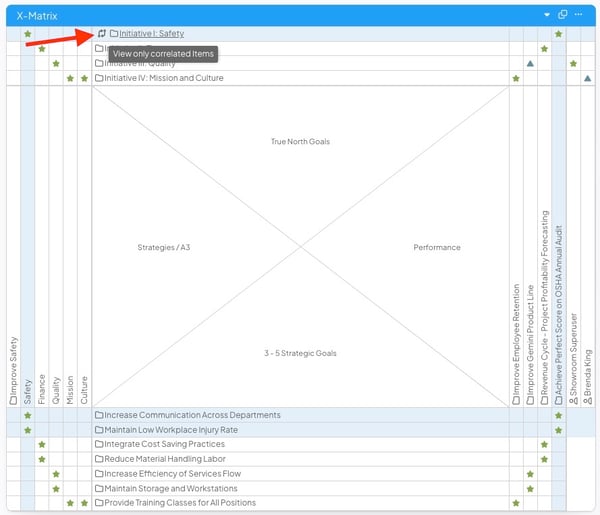
- Select the icon. Only rows associated through Correlation Attributes will appear on your X-Matrix, helping you focus on one portion of the X-Matrix.
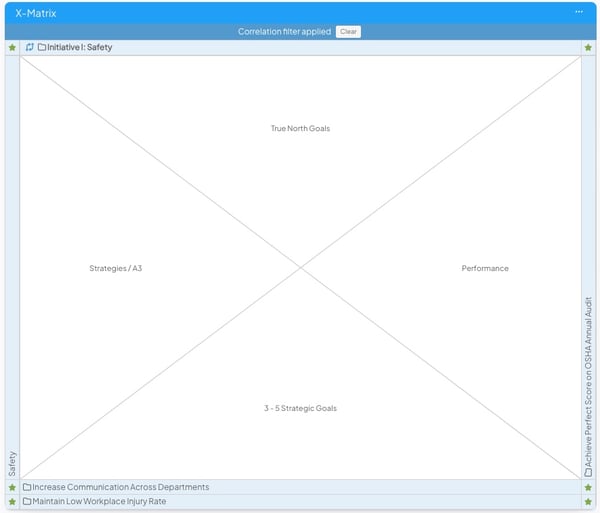
- Only one Correlation filter can be applied at a time.
- Correlation filter will be disabled if the Resources section is set to be at the Bottom of the X-Matrix.
- You can use the Board Filter, Location Filter, or Quick Filters on your Board to further narrow down the results of the Correlation filter. However, if no Items in your Correlation filter meet the requirements of the Board filters, the Correlation filter will be removed.
- Select Clear to remove the Correlation filter.

- The Correlation filter will be removed automatically when you:
- Edit the X-Matrix Card.
- Navigate away from the Board.
- Refresh the Board.
/Ofie/Ofie%20Profile%20Pic.png?width=50&height=50&name=Ofie%20Profile%20Pic.png) Pro Tip: When you export a Board or X-Matrix Card, the Correlation filter will be respected on the PDF.
Pro Tip: When you export a Board or X-Matrix Card, the Correlation filter will be respected on the PDF.